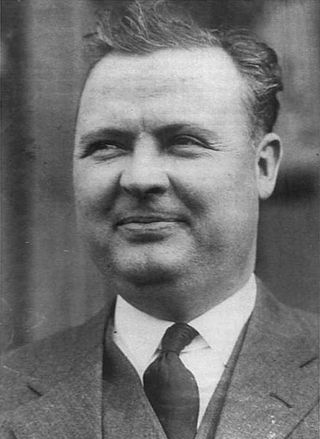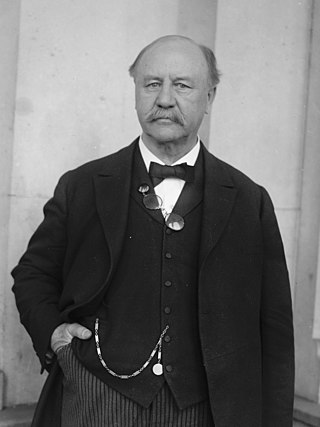
The Ku Klux Klan, commonly shortened to the KKK or the Klan, is the name of an American white supremacist, far-right terrorist organization and hate group. Various historians, including Fergus Bordewich, have characterized the Klan as America's first terrorist group. There have been three distinct iterations with various targets relative to time and place, including African Americans, Jews, and Catholics.

The 1924 United States presidential election was the 35th quadrennial presidential election, held on Tuesday, November 4, 1924. In a three-way contest, incumbent Republican President Calvin Coolidge won election to a full term. Coolidge was the second vice president to ascend to the presidency and then win a full term.

David Curtis "Steve" Stephenson was an American Ku Klux Klan leader, convicted rapist and murderer. In 1923 he was appointed Grand Dragon of the Indiana Klan and head of Klan recruiting for seven other states. Later that year, he led those groups to independence from the national KKK organization. Amassing wealth and political power in Indiana politics, he was one of the most prominent national Klan leaders. He had close relationships with numerous Indiana politicians, especially Governor Edward L. Jackson.

John Calloway Walton was an American politician and the 5th Governor of Oklahoma, serving the shortest tenure. He was impeached and removed from office shortly into his first term. A populist member of the Democratic Party, Walton previously served as the 18th Mayor of Oklahoma City between 1919 and 1923.

The 1924 Democratic National Convention, held at the Madison Square Garden in New York City from June 24 to July 9, 1924, was the longest continuously running convention in United States political history. It took a record 103 ballots to nominate a presidential candidate. It was the first major party national convention that saw the name of a woman, Lena Springs, placed in nomination for vice president. John W. Davis, a dark horse, eventually won the presidential nomination on the 103rd ballot, a compromise candidate following a protracted convention fight between distant front-runners William Gibbs McAdoo and Al Smith.

Edward L. Jackson was an American attorney, judge and politician, elected the 32nd governor of the U.S. state of Indiana from January 12, 1925, to January 14, 1929. He had also been elected as Secretary of State of Indiana.
Daisy Douglas Barr was Imperial Empress (leader) of the Indiana Women's Ku Klux Klan (WKKK) in the early 1920s and an active member of the Women's Christian Temperance Union (WCTU). People were associated with both the KKK and the WCTU because the Ku Klux Klan was a very strong supporter and defender of temperance and National Prohibition. Professionally, she was a Quaker minister in two prominent churches, First Friends Church of New Castle, Indiana, and Friends Memorial Church in Muncie, Indiana. She served as the vice-chair of the Republican Committee in Indiana as well as president of the Indiana War Mother's organization. She was killed in a car wreck and her funeral was held in a Friends meeting.

Samuel Moffett Ralston was an American politician of the Democratic Party who served as the 28th governor of the U.S. state of Indiana and a United States senator from Indiana.

The politics of Louisiana involve political parties, laws and the state constitution, and the many other groups that influence the governance of the state. The state was a one-party Deep South state dominated by the Democratic Party from the end of Reconstruction to the 1960s, forming the backbone of the "Solid South." This was due to the near-total disenfranchisement of the state's large African-American population during this time, who mostly voted Republican. The Civil Rights era turned the state into a competitive one on the federal level, as it voted for the nationwide winner in every election between 1972 and 2004. It remained Democratic on the state and local level until the turn of the 21st century, allowing Republicans to win control of the state legislature and every statewide office in 2011. Republicans won a United States Senate seat for Louisiana in the election of 2004, for the first time since 1876. Republicans captured both seats in the election of 2014 for the first time since 1872. In the election of 2008, the state voted for a losing presidential candidate for the first time since 1968. Democrats won less than 40% of the presidential popular vote in the state in the elections of 2016 and 2020.

The Indiana Republican Party is the affiliate of the United States Republican Party in the state of Indiana. The chairman of the Indiana Republican State Committee is Randy Head.

George Richard Durgan was an American politician who served one term as a U.S. Representative from Indiana from 1933 to 1935.

Harry Emerson Rowbottom was an American businessman and Republican politician. He was elected to the United States House of Representatives from Indiana in 1924 and served three terms from 1925 to 1931. He was defeated for re-election in 1930 and subsequently convicted of accepting bribes, abruptly terminating his political career.

The Indiana Klan was the state of Indiana branch of the Ku Klux Klan, a secret society in the United States that organized in 1915 to promote ideas of racial superiority and affect public affairs on issues of Prohibition, education, political corruption, and morality. Like the rest of the KKK, it was strongly white supremacist against African Americans, Chinese Americans, and also Catholics and Jews, whose faiths were commonly associated with Irish, Italian, Balkan, and Slavic immigrants and their descendants. In Indiana, the Klan did not tend to practice overt violence but used intimidation in certain cases, whereas nationally the organization practiced illegal acts against minority ethnic and religious groups.

William Robinson Pattangall was an American politician from Maine. He was particularly known for his support of public schools and opposition to the Ku Klux Klan. He was later the Chief Justice of the Maine Supreme Judicial Court retiring on July 16, 1935.
Although the Ku Klux Klan is most often associated with white supremacy, the revived Klan of the 1920s was also anti-Catholic. In U.S. states such as Maine, which had a very small black population but a burgeoning number of Acadian, French-Canadian and Irish immigrants, the Klan manifested primarily as a Protestant nativist movement directed against the Catholic minority as well as African-Americans. For a period in the mid-1920s, the Klan captured elements of the Maine Republican Party, even helping to elect a governor, Ralph Owen Brewster.

The 1922 Oregon gubernatorial election took place on November 7, 1922, to elect the governor of the U.S. state of Oregon. The election matched incumbent Republican Ben W. Olcott against Democrat Walter M. Pierce. With the support of the Ku Klux Klan, then a powerful political force in the state, Pierce won the election by a wide margin.

The 1926 Oregon gubernatorial election took place on November 2, 1926 to elect the governor of the U.S. state of Oregon. The election matched incumbent Democrat Walter M. Pierce against Republican Isaac L. Patterson and Independent candidate H. H. Stallard, who ran on an anti-Prohibition platform. Patterson won by a wide margin.
The 1925 Indianapolis mayoral election was held on November 3, 1925 and saw the election of Republican former Marion County treasurer John L. Duvall, who defeated Democratic former Indianapolis city attorney Walter Meyers.

The 1928 United States presidential election in Indiana took place on November 6, 1928, as part of the 1928 United States presidential election which was held throughout all contemporary 48 states. Voters chose 15 representatives, or electors to the Electoral College, who voted for president and vice president.

The 1924 Indiana gubernatorial election took place on November 4, 1924 under the provisions of the Constitution of Indiana. It was the 31st gubernatorial election in the State of Indiana. Republican Edward L. Jackson defeated Democrat Carleton B. McCulloch. The election took place concurrently with the 1924 United States elections that saw Republicans hold the White House and increase their majorities in both houses of Congress.



















